Case Study: Biophysical, Psychosocial Processes in Older Adults' Care
VerifiedAdded on 2022/10/04
|8
|2278
|400
Case Study
AI Summary
This assignment presents two case studies focusing on older adults and their families. The analysis includes discussions of relevant biophysical and psychosocial processes, such as physical activity, social engagement, and well-being. The document identifies appropriate assessment tools, like summative assessments and physical aspects of care, and outlines three key priorities for care in each case, including creating individual care plans, communication, and providing support. Furthermore, the assignment addresses the rights, equity, and access issues pertinent to each case, such as the right to information, informed consent, and appropriate medical care. The cases highlight the importance of considering the holistic needs of older adults, emphasizing the integration of physical, psychological, and social factors in care planning. The document also uses Harvard referencing.
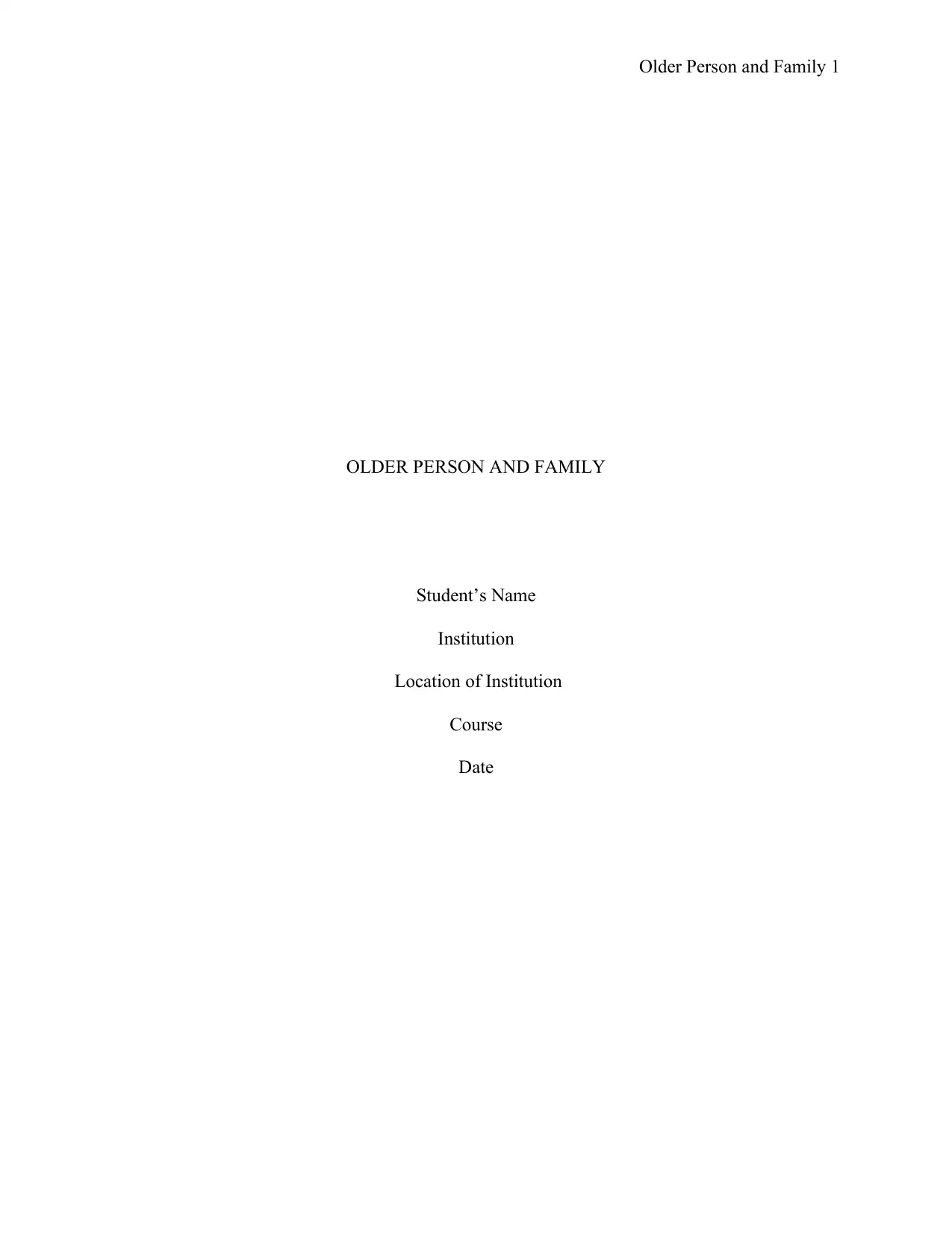
Older Person and Family 1
OLDER PERSON AND FAMILY
Student’s Name
Institution
Location of Institution
Course
Date
OLDER PERSON AND FAMILY
Student’s Name
Institution
Location of Institution
Course
Date
Paraphrase This Document
Need a fresh take? Get an instant paraphrase of this document with our AI Paraphraser
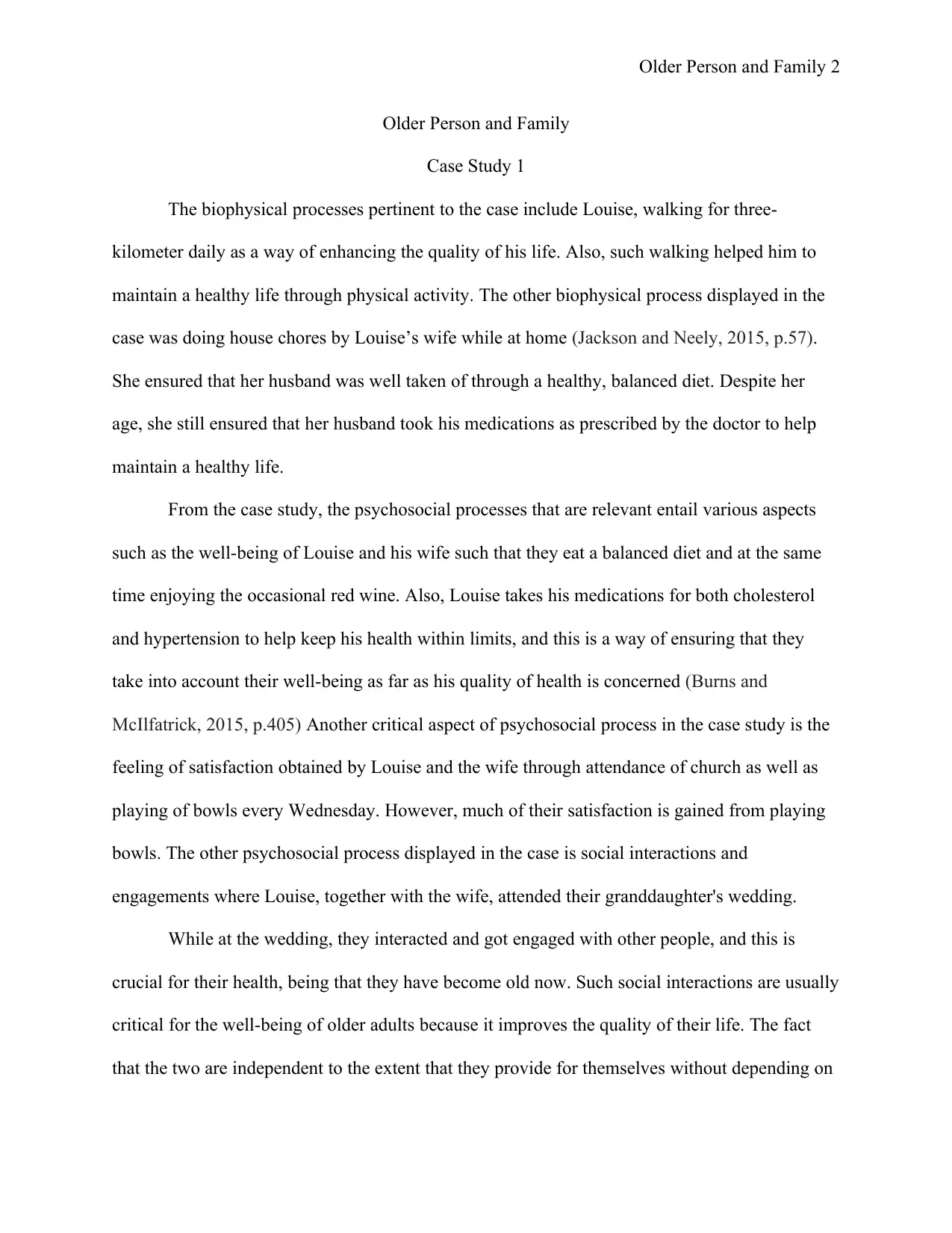
Older Person and Family 2
Older Person and Family
Case Study 1
The biophysical processes pertinent to the case include Louise, walking for three-
kilometer daily as a way of enhancing the quality of his life. Also, such walking helped him to
maintain a healthy life through physical activity. The other biophysical process displayed in the
case was doing house chores by Louise’s wife while at home (Jackson and Neely, 2015, p.57).
She ensured that her husband was well taken of through a healthy, balanced diet. Despite her
age, she still ensured that her husband took his medications as prescribed by the doctor to help
maintain a healthy life.
From the case study, the psychosocial processes that are relevant entail various aspects
such as the well-being of Louise and his wife such that they eat a balanced diet and at the same
time enjoying the occasional red wine. Also, Louise takes his medications for both cholesterol
and hypertension to help keep his health within limits, and this is a way of ensuring that they
take into account their well-being as far as his quality of health is concerned (Burns and
McIlfatrick, 2015, p.405) Another critical aspect of psychosocial process in the case study is the
feeling of satisfaction obtained by Louise and the wife through attendance of church as well as
playing of bowls every Wednesday. However, much of their satisfaction is gained from playing
bowls. The other psychosocial process displayed in the case is social interactions and
engagements where Louise, together with the wife, attended their granddaughter's wedding.
While at the wedding, they interacted and got engaged with other people, and this is
crucial for their health, being that they have become old now. Such social interactions are usually
critical for the well-being of older adults because it improves the quality of their life. The fact
that the two are independent to the extent that they provide for themselves without depending on
Older Person and Family
Case Study 1
The biophysical processes pertinent to the case include Louise, walking for three-
kilometer daily as a way of enhancing the quality of his life. Also, such walking helped him to
maintain a healthy life through physical activity. The other biophysical process displayed in the
case was doing house chores by Louise’s wife while at home (Jackson and Neely, 2015, p.57).
She ensured that her husband was well taken of through a healthy, balanced diet. Despite her
age, she still ensured that her husband took his medications as prescribed by the doctor to help
maintain a healthy life.
From the case study, the psychosocial processes that are relevant entail various aspects
such as the well-being of Louise and his wife such that they eat a balanced diet and at the same
time enjoying the occasional red wine. Also, Louise takes his medications for both cholesterol
and hypertension to help keep his health within limits, and this is a way of ensuring that they
take into account their well-being as far as his quality of health is concerned (Burns and
McIlfatrick, 2015, p.405) Another critical aspect of psychosocial process in the case study is the
feeling of satisfaction obtained by Louise and the wife through attendance of church as well as
playing of bowls every Wednesday. However, much of their satisfaction is gained from playing
bowls. The other psychosocial process displayed in the case is social interactions and
engagements where Louise, together with the wife, attended their granddaughter's wedding.
While at the wedding, they interacted and got engaged with other people, and this is
crucial for their health, being that they have become old now. Such social interactions are usually
critical for the well-being of older adults because it improves the quality of their life. The fact
that the two are independent to the extent that they provide for themselves without depending on
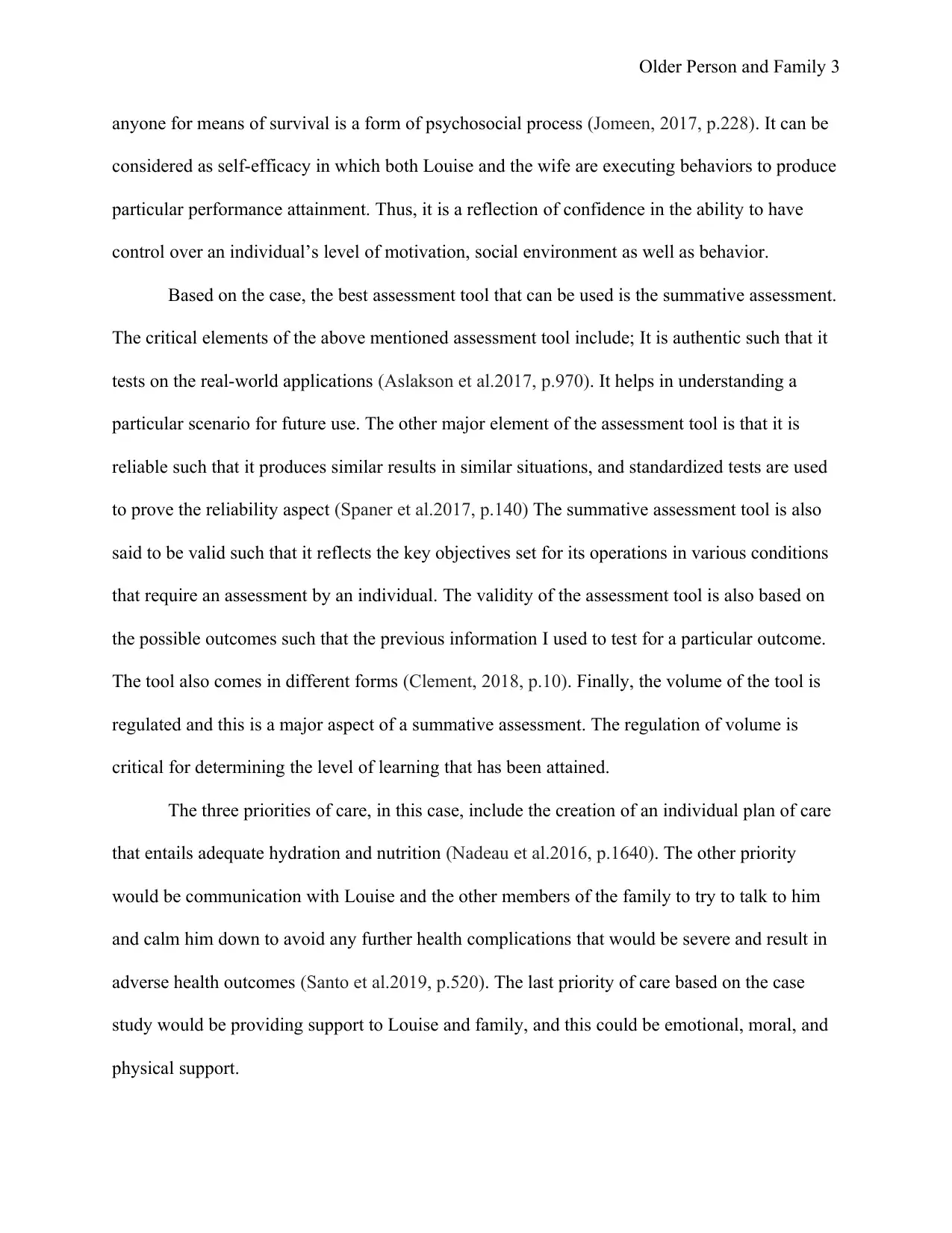
Older Person and Family 3
anyone for means of survival is a form of psychosocial process (Jomeen, 2017, p.228). It can be
considered as self-efficacy in which both Louise and the wife are executing behaviors to produce
particular performance attainment. Thus, it is a reflection of confidence in the ability to have
control over an individual’s level of motivation, social environment as well as behavior.
Based on the case, the best assessment tool that can be used is the summative assessment.
The critical elements of the above mentioned assessment tool include; It is authentic such that it
tests on the real-world applications (Aslakson et al.2017, p.970). It helps in understanding a
particular scenario for future use. The other major element of the assessment tool is that it is
reliable such that it produces similar results in similar situations, and standardized tests are used
to prove the reliability aspect (Spaner et al.2017, p.140) The summative assessment tool is also
said to be valid such that it reflects the key objectives set for its operations in various conditions
that require an assessment by an individual. The validity of the assessment tool is also based on
the possible outcomes such that the previous information I used to test for a particular outcome.
The tool also comes in different forms (Clement, 2018, p.10). Finally, the volume of the tool is
regulated and this is a major aspect of a summative assessment. The regulation of volume is
critical for determining the level of learning that has been attained.
The three priorities of care, in this case, include the creation of an individual plan of care
that entails adequate hydration and nutrition (Nadeau et al.2016, p.1640). The other priority
would be communication with Louise and the other members of the family to try to talk to him
and calm him down to avoid any further health complications that would be severe and result in
adverse health outcomes (Santo et al.2019, p.520). The last priority of care based on the case
study would be providing support to Louise and family, and this could be emotional, moral, and
physical support.
anyone for means of survival is a form of psychosocial process (Jomeen, 2017, p.228). It can be
considered as self-efficacy in which both Louise and the wife are executing behaviors to produce
particular performance attainment. Thus, it is a reflection of confidence in the ability to have
control over an individual’s level of motivation, social environment as well as behavior.
Based on the case, the best assessment tool that can be used is the summative assessment.
The critical elements of the above mentioned assessment tool include; It is authentic such that it
tests on the real-world applications (Aslakson et al.2017, p.970). It helps in understanding a
particular scenario for future use. The other major element of the assessment tool is that it is
reliable such that it produces similar results in similar situations, and standardized tests are used
to prove the reliability aspect (Spaner et al.2017, p.140) The summative assessment tool is also
said to be valid such that it reflects the key objectives set for its operations in various conditions
that require an assessment by an individual. The validity of the assessment tool is also based on
the possible outcomes such that the previous information I used to test for a particular outcome.
The tool also comes in different forms (Clement, 2018, p.10). Finally, the volume of the tool is
regulated and this is a major aspect of a summative assessment. The regulation of volume is
critical for determining the level of learning that has been attained.
The three priorities of care, in this case, include the creation of an individual plan of care
that entails adequate hydration and nutrition (Nadeau et al.2016, p.1640). The other priority
would be communication with Louise and the other members of the family to try to talk to him
and calm him down to avoid any further health complications that would be severe and result in
adverse health outcomes (Santo et al.2019, p.520). The last priority of care based on the case
study would be providing support to Louise and family, and this could be emotional, moral, and
physical support.
⊘ This is a preview!⊘
Do you want full access?
Subscribe today to unlock all pages.

Trusted by 1+ million students worldwide
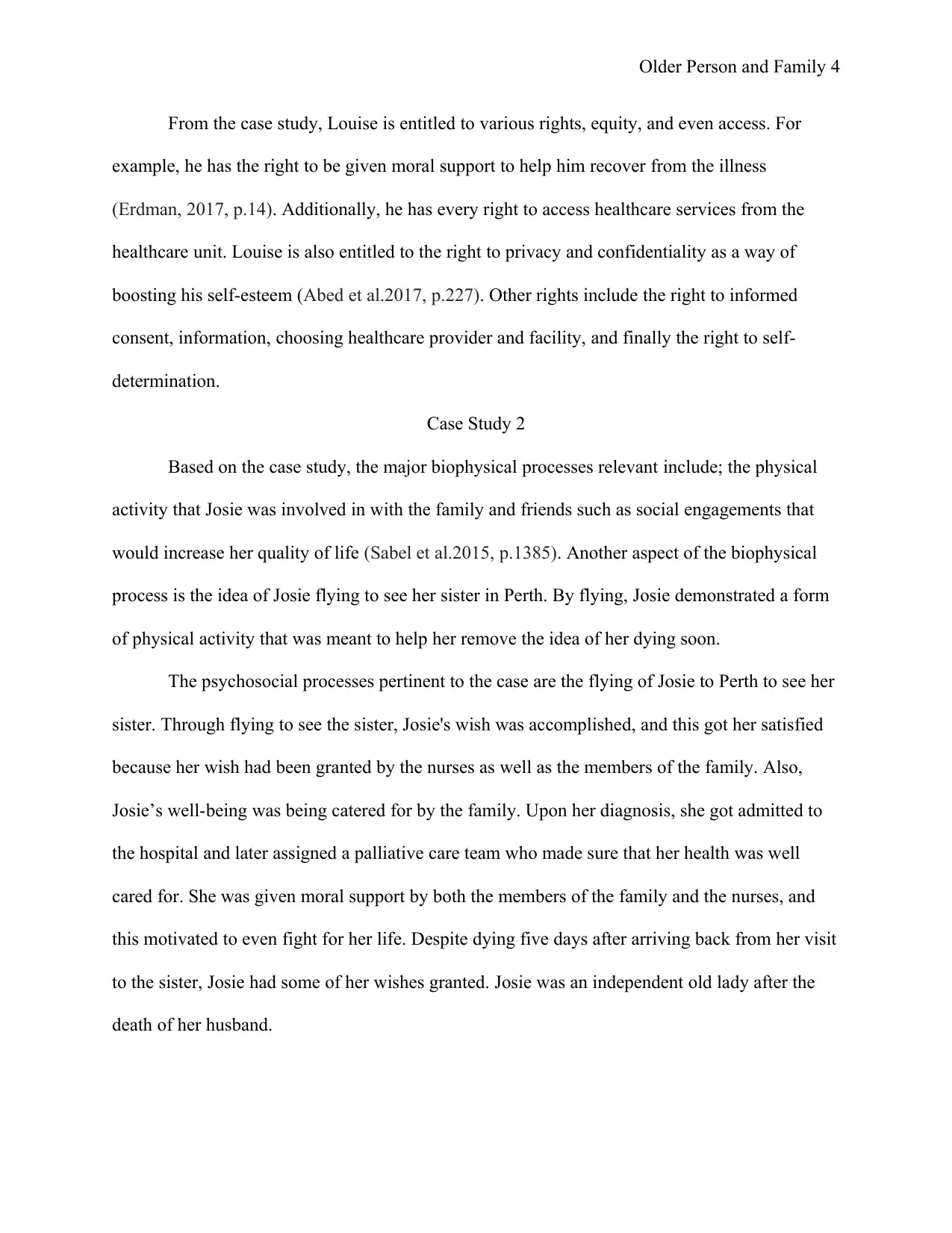
Older Person and Family 4
From the case study, Louise is entitled to various rights, equity, and even access. For
example, he has the right to be given moral support to help him recover from the illness
(Erdman, 2017, p.14). Additionally, he has every right to access healthcare services from the
healthcare unit. Louise is also entitled to the right to privacy and confidentiality as a way of
boosting his self-esteem (Abed et al.2017, p.227). Other rights include the right to informed
consent, information, choosing healthcare provider and facility, and finally the right to self-
determination.
Case Study 2
Based on the case study, the major biophysical processes relevant include; the physical
activity that Josie was involved in with the family and friends such as social engagements that
would increase her quality of life (Sabel et al.2015, p.1385). Another aspect of the biophysical
process is the idea of Josie flying to see her sister in Perth. By flying, Josie demonstrated a form
of physical activity that was meant to help her remove the idea of her dying soon.
The psychosocial processes pertinent to the case are the flying of Josie to Perth to see her
sister. Through flying to see the sister, Josie's wish was accomplished, and this got her satisfied
because her wish had been granted by the nurses as well as the members of the family. Also,
Josie’s well-being was being catered for by the family. Upon her diagnosis, she got admitted to
the hospital and later assigned a palliative care team who made sure that her health was well
cared for. She was given moral support by both the members of the family and the nurses, and
this motivated to even fight for her life. Despite dying five days after arriving back from her visit
to the sister, Josie had some of her wishes granted. Josie was an independent old lady after the
death of her husband.
From the case study, Louise is entitled to various rights, equity, and even access. For
example, he has the right to be given moral support to help him recover from the illness
(Erdman, 2017, p.14). Additionally, he has every right to access healthcare services from the
healthcare unit. Louise is also entitled to the right to privacy and confidentiality as a way of
boosting his self-esteem (Abed et al.2017, p.227). Other rights include the right to informed
consent, information, choosing healthcare provider and facility, and finally the right to self-
determination.
Case Study 2
Based on the case study, the major biophysical processes relevant include; the physical
activity that Josie was involved in with the family and friends such as social engagements that
would increase her quality of life (Sabel et al.2015, p.1385). Another aspect of the biophysical
process is the idea of Josie flying to see her sister in Perth. By flying, Josie demonstrated a form
of physical activity that was meant to help her remove the idea of her dying soon.
The psychosocial processes pertinent to the case are the flying of Josie to Perth to see her
sister. Through flying to see the sister, Josie's wish was accomplished, and this got her satisfied
because her wish had been granted by the nurses as well as the members of the family. Also,
Josie’s well-being was being catered for by the family. Upon her diagnosis, she got admitted to
the hospital and later assigned a palliative care team who made sure that her health was well
cared for. She was given moral support by both the members of the family and the nurses, and
this motivated to even fight for her life. Despite dying five days after arriving back from her visit
to the sister, Josie had some of her wishes granted. Josie was an independent old lady after the
death of her husband.
Paraphrase This Document
Need a fresh take? Get an instant paraphrase of this document with our AI Paraphraser
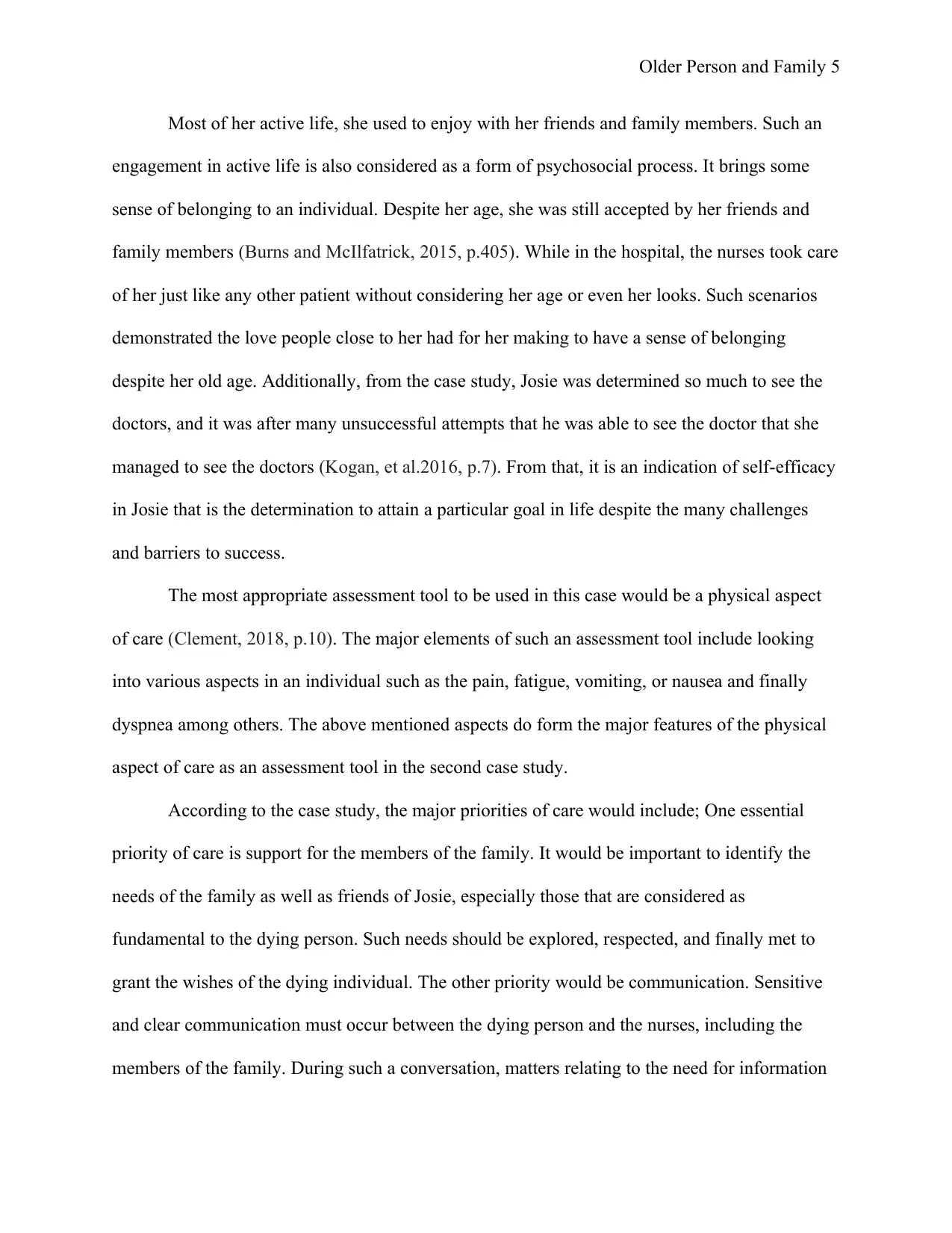
Older Person and Family 5
Most of her active life, she used to enjoy with her friends and family members. Such an
engagement in active life is also considered as a form of psychosocial process. It brings some
sense of belonging to an individual. Despite her age, she was still accepted by her friends and
family members (Burns and McIlfatrick, 2015, p.405). While in the hospital, the nurses took care
of her just like any other patient without considering her age or even her looks. Such scenarios
demonstrated the love people close to her had for her making to have a sense of belonging
despite her old age. Additionally, from the case study, Josie was determined so much to see the
doctors, and it was after many unsuccessful attempts that he was able to see the doctor that she
managed to see the doctors (Kogan, et al.2016, p.7). From that, it is an indication of self-efficacy
in Josie that is the determination to attain a particular goal in life despite the many challenges
and barriers to success.
The most appropriate assessment tool to be used in this case would be a physical aspect
of care (Clement, 2018, p.10). The major elements of such an assessment tool include looking
into various aspects in an individual such as the pain, fatigue, vomiting, or nausea and finally
dyspnea among others. The above mentioned aspects do form the major features of the physical
aspect of care as an assessment tool in the second case study.
According to the case study, the major priorities of care would include; One essential
priority of care is support for the members of the family. It would be important to identify the
needs of the family as well as friends of Josie, especially those that are considered as
fundamental to the dying person. Such needs should be explored, respected, and finally met to
grant the wishes of the dying individual. The other priority would be communication. Sensitive
and clear communication must occur between the dying person and the nurses, including the
members of the family. During such a conversation, matters relating to the need for information
Most of her active life, she used to enjoy with her friends and family members. Such an
engagement in active life is also considered as a form of psychosocial process. It brings some
sense of belonging to an individual. Despite her age, she was still accepted by her friends and
family members (Burns and McIlfatrick, 2015, p.405). While in the hospital, the nurses took care
of her just like any other patient without considering her age or even her looks. Such scenarios
demonstrated the love people close to her had for her making to have a sense of belonging
despite her old age. Additionally, from the case study, Josie was determined so much to see the
doctors, and it was after many unsuccessful attempts that he was able to see the doctor that she
managed to see the doctors (Kogan, et al.2016, p.7). From that, it is an indication of self-efficacy
in Josie that is the determination to attain a particular goal in life despite the many challenges
and barriers to success.
The most appropriate assessment tool to be used in this case would be a physical aspect
of care (Clement, 2018, p.10). The major elements of such an assessment tool include looking
into various aspects in an individual such as the pain, fatigue, vomiting, or nausea and finally
dyspnea among others. The above mentioned aspects do form the major features of the physical
aspect of care as an assessment tool in the second case study.
According to the case study, the major priorities of care would include; One essential
priority of care is support for the members of the family. It would be important to identify the
needs of the family as well as friends of Josie, especially those that are considered as
fundamental to the dying person. Such needs should be explored, respected, and finally met to
grant the wishes of the dying individual. The other priority would be communication. Sensitive
and clear communication must occur between the dying person and the nurses, including the
members of the family. During such a conversation, matters relating to the need for information
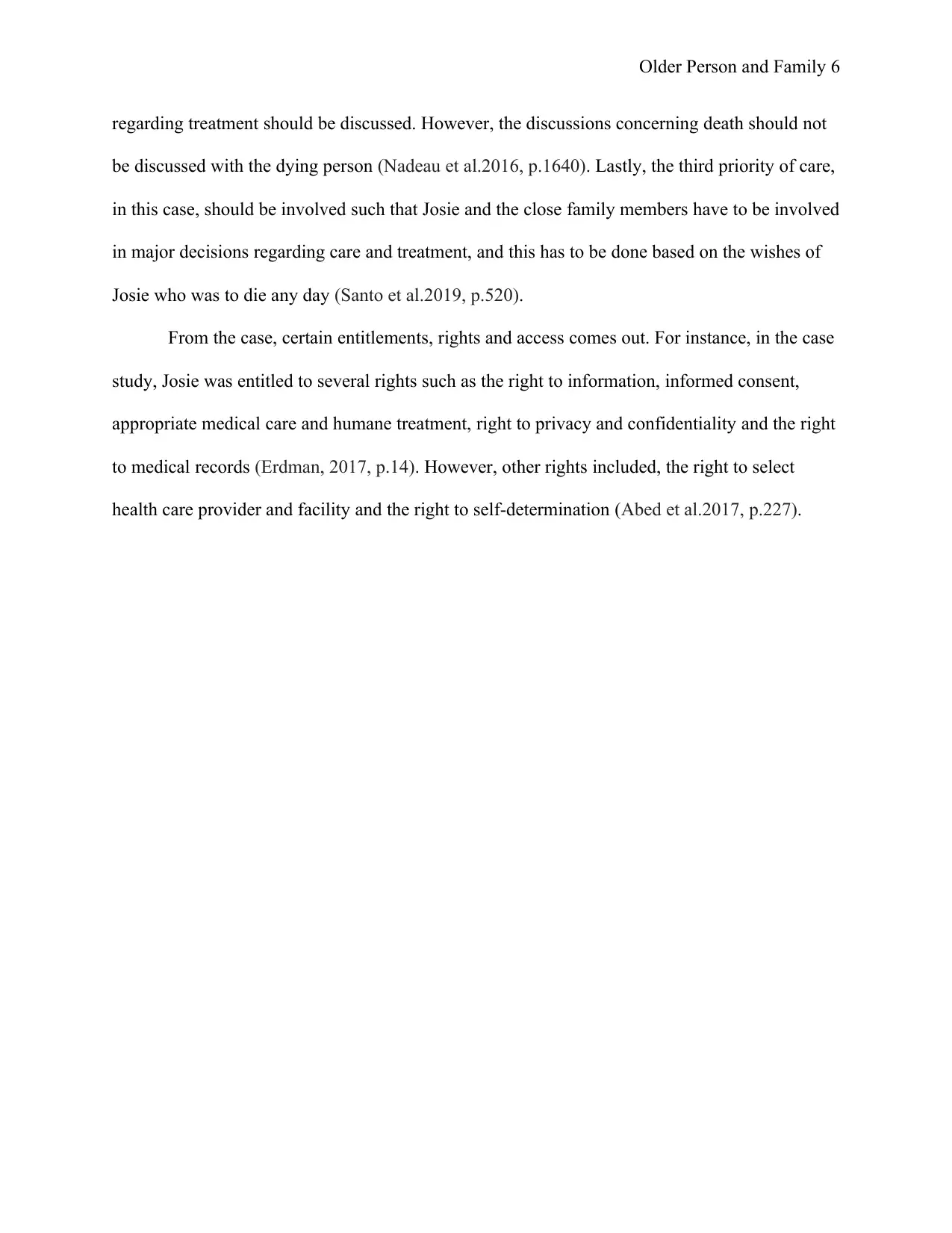
Older Person and Family 6
regarding treatment should be discussed. However, the discussions concerning death should not
be discussed with the dying person (Nadeau et al.2016, p.1640). Lastly, the third priority of care,
in this case, should be involved such that Josie and the close family members have to be involved
in major decisions regarding care and treatment, and this has to be done based on the wishes of
Josie who was to die any day (Santo et al.2019, p.520).
From the case, certain entitlements, rights and access comes out. For instance, in the case
study, Josie was entitled to several rights such as the right to information, informed consent,
appropriate medical care and humane treatment, right to privacy and confidentiality and the right
to medical records (Erdman, 2017, p.14). However, other rights included, the right to select
health care provider and facility and the right to self-determination (Abed et al.2017, p.227).
regarding treatment should be discussed. However, the discussions concerning death should not
be discussed with the dying person (Nadeau et al.2016, p.1640). Lastly, the third priority of care,
in this case, should be involved such that Josie and the close family members have to be involved
in major decisions regarding care and treatment, and this has to be done based on the wishes of
Josie who was to die any day (Santo et al.2019, p.520).
From the case, certain entitlements, rights and access comes out. For instance, in the case
study, Josie was entitled to several rights such as the right to information, informed consent,
appropriate medical care and humane treatment, right to privacy and confidentiality and the right
to medical records (Erdman, 2017, p.14). However, other rights included, the right to select
health care provider and facility and the right to self-determination (Abed et al.2017, p.227).
⊘ This is a preview!⊘
Do you want full access?
Subscribe today to unlock all pages.

Trusted by 1+ million students worldwide
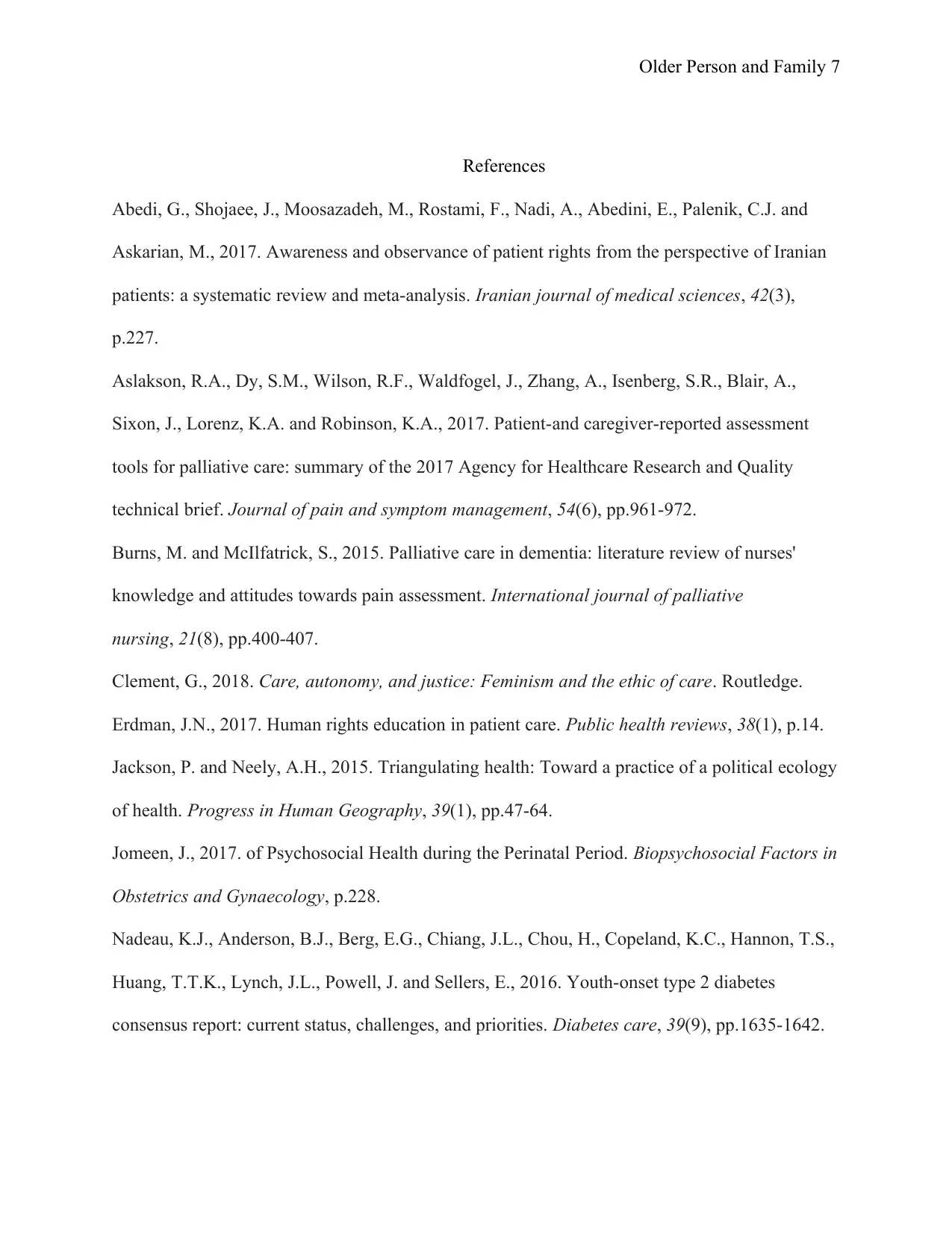
Older Person and Family 7
References
Abedi, G., Shojaee, J., Moosazadeh, M., Rostami, F., Nadi, A., Abedini, E., Palenik, C.J. and
Askarian, M., 2017. Awareness and observance of patient rights from the perspective of Iranian
patients: a systematic review and meta-analysis. Iranian journal of medical sciences, 42(3),
p.227.
Aslakson, R.A., Dy, S.M., Wilson, R.F., Waldfogel, J., Zhang, A., Isenberg, S.R., Blair, A.,
Sixon, J., Lorenz, K.A. and Robinson, K.A., 2017. Patient-and caregiver-reported assessment
tools for palliative care: summary of the 2017 Agency for Healthcare Research and Quality
technical brief. Journal of pain and symptom management, 54(6), pp.961-972.
Burns, M. and McIlfatrick, S., 2015. Palliative care in dementia: literature review of nurses'
knowledge and attitudes towards pain assessment. International journal of palliative
nursing, 21(8), pp.400-407.
Clement, G., 2018. Care, autonomy, and justice: Feminism and the ethic of care. Routledge.
Erdman, J.N., 2017. Human rights education in patient care. Public health reviews, 38(1), p.14.
Jackson, P. and Neely, A.H., 2015. Triangulating health: Toward a practice of a political ecology
of health. Progress in Human Geography, 39(1), pp.47-64.
Jomeen, J., 2017. of Psychosocial Health during the Perinatal Period. Biopsychosocial Factors in
Obstetrics and Gynaecology, p.228.
Nadeau, K.J., Anderson, B.J., Berg, E.G., Chiang, J.L., Chou, H., Copeland, K.C., Hannon, T.S.,
Huang, T.T.K., Lynch, J.L., Powell, J. and Sellers, E., 2016. Youth-onset type 2 diabetes
consensus report: current status, challenges, and priorities. Diabetes care, 39(9), pp.1635-1642.
References
Abedi, G., Shojaee, J., Moosazadeh, M., Rostami, F., Nadi, A., Abedini, E., Palenik, C.J. and
Askarian, M., 2017. Awareness and observance of patient rights from the perspective of Iranian
patients: a systematic review and meta-analysis. Iranian journal of medical sciences, 42(3),
p.227.
Aslakson, R.A., Dy, S.M., Wilson, R.F., Waldfogel, J., Zhang, A., Isenberg, S.R., Blair, A.,
Sixon, J., Lorenz, K.A. and Robinson, K.A., 2017. Patient-and caregiver-reported assessment
tools for palliative care: summary of the 2017 Agency for Healthcare Research and Quality
technical brief. Journal of pain and symptom management, 54(6), pp.961-972.
Burns, M. and McIlfatrick, S., 2015. Palliative care in dementia: literature review of nurses'
knowledge and attitudes towards pain assessment. International journal of palliative
nursing, 21(8), pp.400-407.
Clement, G., 2018. Care, autonomy, and justice: Feminism and the ethic of care. Routledge.
Erdman, J.N., 2017. Human rights education in patient care. Public health reviews, 38(1), p.14.
Jackson, P. and Neely, A.H., 2015. Triangulating health: Toward a practice of a political ecology
of health. Progress in Human Geography, 39(1), pp.47-64.
Jomeen, J., 2017. of Psychosocial Health during the Perinatal Period. Biopsychosocial Factors in
Obstetrics and Gynaecology, p.228.
Nadeau, K.J., Anderson, B.J., Berg, E.G., Chiang, J.L., Chou, H., Copeland, K.C., Hannon, T.S.,
Huang, T.T.K., Lynch, J.L., Powell, J. and Sellers, E., 2016. Youth-onset type 2 diabetes
consensus report: current status, challenges, and priorities. Diabetes care, 39(9), pp.1635-1642.
Paraphrase This Document
Need a fresh take? Get an instant paraphrase of this document with our AI Paraphraser
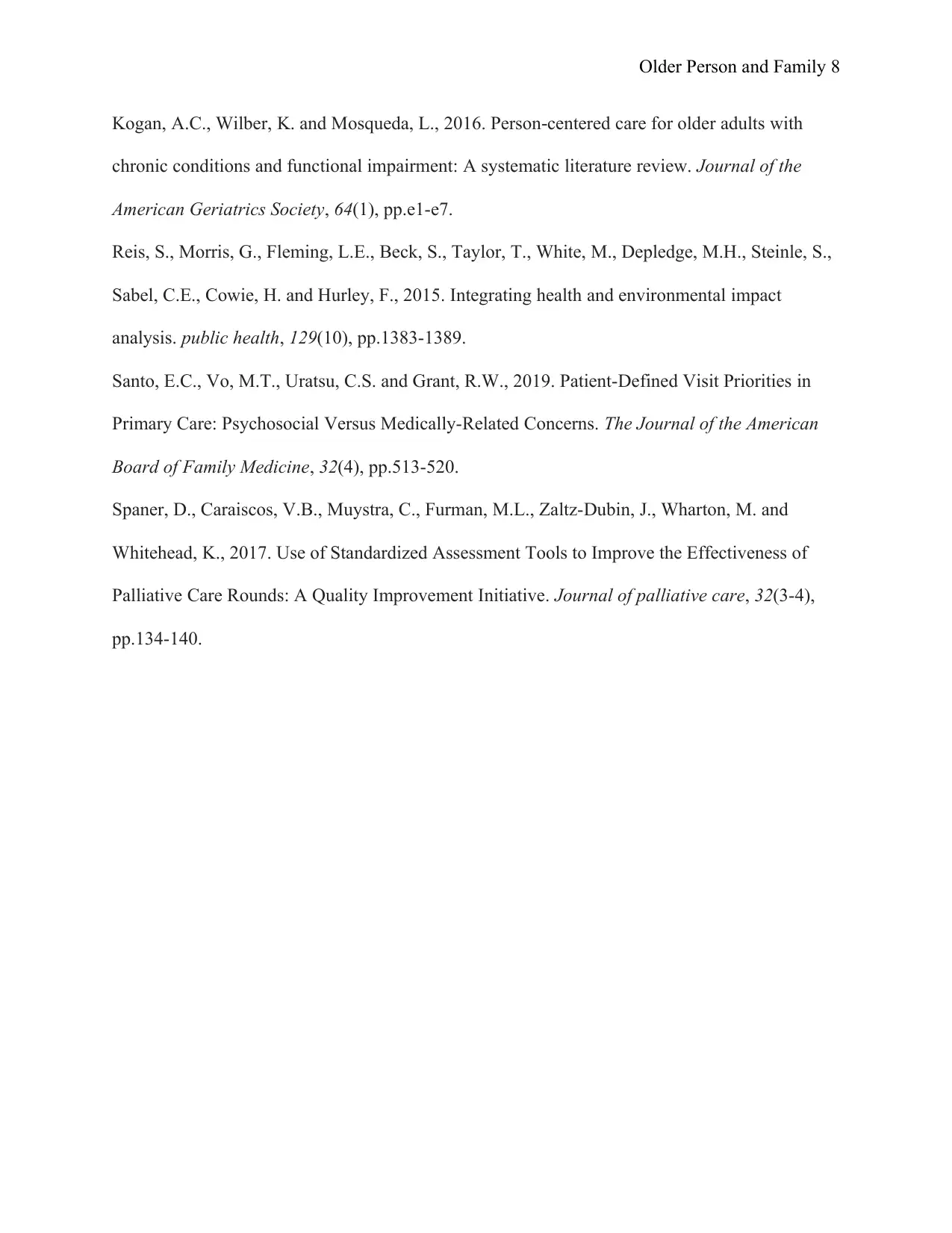
Older Person and Family 8
Kogan, A.C., Wilber, K. and Mosqueda, L., 2016. Person centered care for older adults with‐
chronic conditions and functional impairment: A systematic literature review. Journal of the
American Geriatrics Society, 64(1), pp.e1-e7.
Reis, S., Morris, G., Fleming, L.E., Beck, S., Taylor, T., White, M., Depledge, M.H., Steinle, S.,
Sabel, C.E., Cowie, H. and Hurley, F., 2015. Integrating health and environmental impact
analysis. public health, 129(10), pp.1383-1389.
Santo, E.C., Vo, M.T., Uratsu, C.S. and Grant, R.W., 2019. Patient-Defined Visit Priorities in
Primary Care: Psychosocial Versus Medically-Related Concerns. The Journal of the American
Board of Family Medicine, 32(4), pp.513-520.
Spaner, D., Caraiscos, V.B., Muystra, C., Furman, M.L., Zaltz-Dubin, J., Wharton, M. and
Whitehead, K., 2017. Use of Standardized Assessment Tools to Improve the Effectiveness of
Palliative Care Rounds: A Quality Improvement Initiative. Journal of palliative care, 32(3-4),
pp.134-140.
Kogan, A.C., Wilber, K. and Mosqueda, L., 2016. Person centered care for older adults with‐
chronic conditions and functional impairment: A systematic literature review. Journal of the
American Geriatrics Society, 64(1), pp.e1-e7.
Reis, S., Morris, G., Fleming, L.E., Beck, S., Taylor, T., White, M., Depledge, M.H., Steinle, S.,
Sabel, C.E., Cowie, H. and Hurley, F., 2015. Integrating health and environmental impact
analysis. public health, 129(10), pp.1383-1389.
Santo, E.C., Vo, M.T., Uratsu, C.S. and Grant, R.W., 2019. Patient-Defined Visit Priorities in
Primary Care: Psychosocial Versus Medically-Related Concerns. The Journal of the American
Board of Family Medicine, 32(4), pp.513-520.
Spaner, D., Caraiscos, V.B., Muystra, C., Furman, M.L., Zaltz-Dubin, J., Wharton, M. and
Whitehead, K., 2017. Use of Standardized Assessment Tools to Improve the Effectiveness of
Palliative Care Rounds: A Quality Improvement Initiative. Journal of palliative care, 32(3-4),
pp.134-140.
1 out of 8
Related Documents
Your All-in-One AI-Powered Toolkit for Academic Success.
+13062052269
info@desklib.com
Available 24*7 on WhatsApp / Email
![[object Object]](/_next/static/media/star-bottom.7253800d.svg)
Unlock your academic potential
Copyright © 2020–2025 A2Z Services. All Rights Reserved. Developed and managed by ZUCOL.



